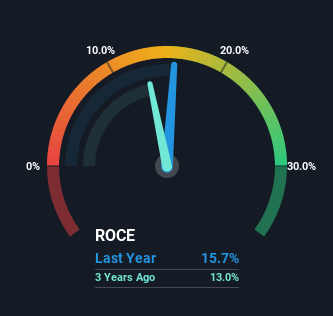- South Africa
- /
- Food and Staples Retail
- /
- JSE:SHP
Shoprite Holdings (JSE:SHP) Could Be Struggling To Allocate Capital

If you're looking for a multi-bagger, there's a few things to keep an eye out for. Typically, we'll want to notice a trend of growing return on capital employed (ROCE) and alongside that, an expanding base of capital employed. Basically this means that a company has profitable initiatives that it can continue to reinvest in, which is a trait of a compounding machine. However, after investigating Shoprite Holdings (JSE:SHP), we don't think it's current trends fit the mold of a multi-bagger.
Understanding Return On Capital Employed (ROCE)
For those that aren't sure what ROCE is, it measures the amount of pre-tax profits a company can generate from the capital employed in its business. Analysts use this formula to calculate it for Shoprite Holdings:
Return on Capital Employed = Earnings Before Interest and Tax (EBIT) ÷ (Total Assets - Current Liabilities)
0.16 = R9.2b ÷ (R91b - R32b) (Based on the trailing twelve months to July 2022).
Therefore, Shoprite Holdings has an ROCE of 16%. That's a pretty standard return and it's in line with the industry average of 16%.
Check out the opportunities and risks within the ZA Consumer Retailing industry.

Above you can see how the current ROCE for Shoprite Holdings compares to its prior returns on capital, but there's only so much you can tell from the past. If you'd like, you can check out the forecasts from the analysts covering Shoprite Holdings here for free.
What The Trend Of ROCE Can Tell Us
In terms of Shoprite Holdings' historical ROCE movements, the trend isn't fantastic. Around five years ago the returns on capital were 26%, but since then they've fallen to 16%. On the other hand, the company has been employing more capital without a corresponding improvement in sales in the last year, which could suggest these investments are longer term plays. It's worth keeping an eye on the company's earnings from here on to see if these investments do end up contributing to the bottom line.
On a related note, Shoprite Holdings has decreased its current liabilities to 36% of total assets. So we could link some of this to the decrease in ROCE. Effectively this means their suppliers or short-term creditors are funding less of the business, which reduces some elements of risk. Since the business is basically funding more of its operations with it's own money, you could argue this has made the business less efficient at generating ROCE.
The Bottom Line On Shoprite Holdings' ROCE
Bringing it all together, while we're somewhat encouraged by Shoprite Holdings' reinvestment in its own business, we're aware that returns are shrinking. Unsurprisingly, the stock has only gained 27% over the last five years, which potentially indicates that investors are accounting for this going forward. So if you're looking for a multi-bagger, the underlying trends indicate you may have better chances elsewhere.
One more thing to note, we've identified 1 warning sign with Shoprite Holdings and understanding this should be part of your investment process.
For those who like to invest in solid companies, check out this free list of companies with solid balance sheets and high returns on equity.
New: Manage All Your Stock Portfolios in One Place
We've created the ultimate portfolio companion for stock investors, and it's free.
• Connect an unlimited number of Portfolios and see your total in one currency
• Be alerted to new Warning Signs or Risks via email or mobile
• Track the Fair Value of your stocks
Have feedback on this article? Concerned about the content? Get in touch with us directly. Alternatively, email editorial-team (at) simplywallst.com.
This article by Simply Wall St is general in nature. We provide commentary based on historical data and analyst forecasts only using an unbiased methodology and our articles are not intended to be financial advice. It does not constitute a recommendation to buy or sell any stock, and does not take account of your objectives, or your financial situation. We aim to bring you long-term focused analysis driven by fundamental data. Note that our analysis may not factor in the latest price-sensitive company announcements or qualitative material. Simply Wall St has no position in any stocks mentioned.
About JSE:SHP
Shoprite Holdings
An investment holding company, primarily engages in the food retailing business in South Africa and internationally.
Flawless balance sheet with moderate growth potential.

